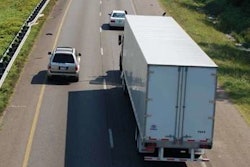
The DRIVE Safe Act, part of the $1.2 trillion infrastructure bill President Joe Biden signed into law on Monday, has created a pathway for drivers under 21 years old to enter interstate trucking just as it's become more vital, and more profitable, than ever before.
Senator Angus King (I-Maine) on Wednesday held a call with reporters to discuss the finer points of the bill, which he described as a common sense piece of legislation that could quickly free up tens of thousands of drivers and help ease the country's supply chain crunch.
The bill establishes an apprenticeship program for young adults, already eligible to hold CDLs and operate Class 8 tractors, to simply cross state lines. King said that while he was initially reluctant to allow younger drivers into interstate long haul trucking, the arbitrary reality of state lines finally convinced him.
"Right now 18-year-olds can drive from Portland, Maine, to Kittering, Maine, which is longer than Portland to New York City," said King. "The 18-year-olds can drive in those contexts, but they can’t go across border."
King pointed to the program as a fast way to move the needle on inflation and persistent material shortages amid a historically tight freight market, but also a safe way to help drivers early in their careers.
"The program requires candidates to utilize industry-leading technology including: active braking collision mitigation systems, forward-facing event recording cameras, speed limiters set at 65 mph or less and [automated manual] transmissions. Candidates are required to successfully progress through two probationary driver periods – alongside an experienced driver – and demonstrate competency and proficiency behind-the wheel across 12 performance benchmarks," King's office said of the program. The program requires young drivers spend 240 hours supervised by an experienced driver and 400 hours driving over all.
King added that the program would be made available for drivers through their employers, so it's doubtful young owner-operators can opt in just yet.
King estimated that within two to three months young drivers could complete the program and begin hauling over the road. Currently, the Bureau of Labor Statistics says 61,000 workers between 16 and 19 work within the commercial driving and sales occupation.
American Trucking Associations President Chris Spear, testifying to the House Transportation and Infrastructure Committee on the same day, expressed strong support for the act.
"Right now 49 states allow an 18-year-old to drive a Class 8 truck, and you can drive with absolutely no training and no tech requirements," Spear said of the current standard, which only allows young drivers to operate within a state.
"We’re sending 18-year-olds overseas to defend our freedom and do the unthinkable," added Spear, who has a child in the military. "I’m pretty sure if we can train them to do that we can train them to cross state lines."
The Owner-Operator Independent Drivers Association, for its part, is on the record as "staunchly" opposing the DRIVE Safe act.
Reporters asked King about how the bill would ensure the safety of trainee drivers under supervision and if insurers would cover the young drivers. King's answer was simple: The DRIVE Safe act will not do those things.
"This isn’t a comprehensive bill to solve all the problems of the long haul trucking industry," said King. "This isn’t a comprehensive truck driver improvement act. This is a narrowly drafted piece of legislation that will address part of the problem, not all of it."
As far as securing the buy-in of insurers, King said the bill addressed it "not explicitly but implicitly," with the increased safety requirements. "The whole panoply of safety requirements were all designed to give comfort to the traveling public in terms of safety and clearly to the insurance industry that these people are not a risk. In terms of the risk to the insurance companies, I’m not sure it really expands substantially," he continued.
Overall, King said even though the measure didn't address all the recruiting and retention issues in long haul trucking, he was confident the measure would increase the pool of eligible drivers by tackling an issue "particularly amenable to a legislative solution."
"We’re talking about people that are already in the industry. They already have CDLs in their state. They've already made that decision," he said.














